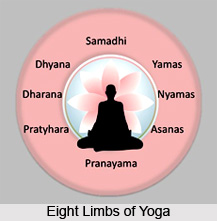 The twenty-ninth yoga sutra speaks about the cognition of a Pole Star, and a sadhaka coming to know the course of his fate. By such a cognitive stage, he also comes to know about the movement of the stars and other epoch-making events that can come upon the universe. The course of fate and how can one govern the other elements, is illustrated thorugh a legendary story.
The twenty-ninth yoga sutra speaks about the cognition of a Pole Star, and a sadhaka coming to know the course of his fate. By such a cognitive stage, he also comes to know about the movement of the stars and other epoch-making events that can come upon the universe. The course of fate and how can one govern the other elements, is illustrated thorugh a legendary story.
dhruve fixed, firm, permanent, the Pole Star, era, tip of the nose
tat from that, of their
gati movement, course of events, fortune
jnanam knowledge
By samyama on the Pole Star, the yogi knows the course of destiny.
By samyama on the Pole Star (dhruva naksatra), a yogi knows the movements of stars and their effect on the events of the world. Dhruva also represents the roof (ajna cakra) as well as the tip of the nose (nasagra). The yogi will know in advance about his own destiny, as well as that of others.
King Uttanapada had two wives - Suniti and Suruchi. Though Suniti was the queen, the king was very fond of his second wife Suruchi. Each of them had a son. The elder one was Dhruva and the younger one Uttama. One day Prince Uttama was playing, sitting on his father`s lap. Dhruva too came to sit on his father`s lap; but Suruchi, the mother of Uttama pulled him away, scolding him that he had to observe tapas. Dhruva went to his own mother, narrated the incident and begged her to permit him to go to the forest to do tapas and acquire the kingdom. It so happened that the sapta risis - the seven stars of the constellation Ursa Major, gave him a mantra and with that mantra Dhruva persistently prayed to Lord Vishnu to bless him with the kingdom. Lord Vishnu was pleased by his unwavering tapas at such a young age. He granted his wish and named a star after him, Dhruva Nakshatra, known to all of humankind as the Pole Star.




















